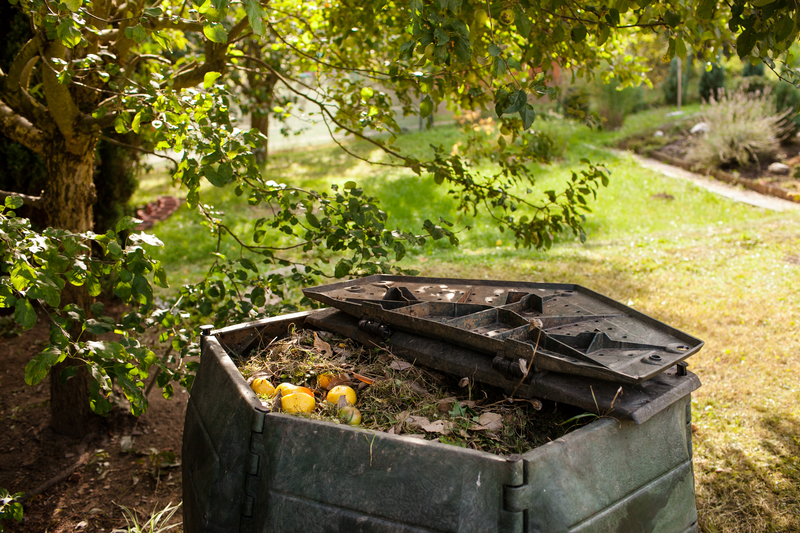Cleaner Communities Through Improved Packaging and Cardboard Disposal Systems
In today's fast-paced world, packaging plays a pivotal role in preserving products, supporting logistics, and enhancing brand recognition. However, the consequences of excessive and poorly managed packaging -- especially cardboard waste -- can significantly impact the cleanliness and sustainability of our communities. This article delves deep into how improved packaging and cardboard disposal systems can foster cleaner, healthier neighborhoods, aligning with environmental stewardship and public welfare.

The Impact of Packaging and Cardboard Waste on Communities
Packaging, particularly cardboard packaging, is omnipresent -- found in everything from food deliveries to online shopping parcels. Although cardboard is one of the most recyclable materials, mismanagement in its disposal has turned it into a leading cause of urban litter and landfill crowding. To better appreciate the significance of enhanced cardboard waste management, let's examine the challenges posed by improper disposal:
- Overfilled bins: Overflowing waste bins due to unflattened cardboard creates eyesores and attracts pests.
- Street litter: Wind can easily blow loose cardboard onto streets, parks, and waterways.
- Landfill pressure: Cardboard that's contaminated with oils, food, or other waste often ends up in landfills instead of recycling plants.
- Fire hazard: Accumulated cardboard provides fuel for fires, particularly in dry climates.
These issues demonstrate why improving packaging and optimizing cardboard disposal systems is essential to achieving cleaner, more sustainable communities.
Evolving Packaging Practices for a Cleaner Tomorrow
Why Rethink Packaging?
To address environmental concerns, modern packaging must go beyond function and aesthetics. It needs to consider the end-of-life impact of materials, especially popular ones like cardboard. Here's why it matters:
- Resource conservation: Reducing the amount of packaging and prioritizing recyclable materials lessens our dependency on raw resources.
- Pollution reduction: Cleaner packaging reduces the risk of litter and the pollution of waterways and green spaces.
- Boosting public health: Less packaging waste means fewer pest infestations, unpleasant odors, and fewer urban fire risks.
- Enhancing aesthetics: Cleaner streets improve community pride and supports local tourism and business.
Steps Towards Better Packaging
Advancements in packaging design and materials can drastically reduce the negative effects of waste. Here are several strategies for smart packaging for cleaner communities:
-
Minimalist design:
- Reduce packaging layers, inks, and unnecessary finishes.
- Utilize right-sized boxes to eliminate excess cardboard.
-
Biodegradable and compostable alternatives:
- Explore alternatives to coated or laminated cardboard, which are often not recyclable.
-
Reusable packaging:
- Encourage systems where packaging can be returned and reused, such as subscription service boxes.
-
Clear labeling:
- Mark packages with disposal and recycling instructions to lower contamination rates.
-
Innovation in materials:
- Adopt packaging made from recycled content or with embedded technology to track recycling rates.
By adopting these methods, companies and consumers can both play roles in supporting greener packaging and cardboard waste reduction.
Optimizing Cardboard Disposal: Critical to Cleaner Neighborhoods
Challenges Facing Cardboard Waste Management
Even with recyclable cardboard, improper disposal can render whole batches of recycling unusable. Common problems include food contamination, wet cardboard, and failure to flatten boxes. The sheer volume of cardboard generated in peak retail seasons also strains municipal recycling capacity, amplifying the need for improved systems.
Effective Cardboard Disposal Solutions
The pathway to community cleanliness through effective cardboard disposal systems requires collaboration between individuals, businesses, and government agencies. Here's how:
-
Public awareness campaigns:
- Educate residents about proper cardboard recycling practices including flattening boxes and removing contaminants.
-
Enhanced curbside recycling:
- Schedule more frequent pickups in high-volume periods and supply larger or additional bins for households and businesses.
-
Comprehensive recycling facilities:
- Invest in community recycling centers equipped to process large quantities of cardboard, including mixed and soiled materials through advanced sorting and cleaning technology.
-
Drop-off points for large cardboard:
- Provide easily accessible drop-off sites for items that don't fit in standard collection bins, such as moving boxes and bulk packaging.
-
Support for local businesses:
- Offer incentives and recognition for businesses that use sustainable packaging or set up in-store recycling programs for customers.
Role of Technology in Cardboard Disposal Systems
The integration of smart technologies can revolutionize packaging waste management:
- Smart bins: Sensors alert city officials when bins are full, enabling optimized collection routes and reducing urban litter.
- App-guided recycling: Mobile apps tell residents how and when to recycle packaging and notify about contamination issues.
- Robotic sorting: AI-powered sorting machines at recycling facilities improve recovery rates and save on manual labor.
By leveraging innovative technology, communities can maximize recycling efficiency and minimize improper disposal, paving the way for a cleaner urban environment.
The Role of Businesses in Cleaner Packaging and Disposal
Corporate Social Responsibility and Packaging Choices
Brands have a remarkable influence over the scale and nature of packaging waste. As consumer expectations shift toward sustainability, businesses that prioritize eco-friendly packaging and cardboard recycling not only foster goodwill but also meet evolving regulatory standards.
Key steps companies can take include:
- Sourcing from sustainable suppliers: Choose recycled or certified cardboard to reduce environmental impact.
- Offering returnable packaging: Implement programs that encourage customers to return packaging for reuse or recycling.
- Tracking environmental impact: Regularly assess and report packaging waste metrics to remain transparent and accountable.
- Supporting community initiatives: Partner with local authorities and NGOs on disposal and cleanup efforts.
Retail Innovations and Customer Engagement
- Promoting consumer responsibility: Use in-store signage, online tutorials, and printed materials to inform customers about correct cardboard disposal and recycling methods.
- Loyalty rewards for returns: Offer discounts or incentives to customers who bring back packaging for recycling.
Cleaner packaging systems not only reduce environmental harm but also serve as powerful marketing messages that attract eco-conscious customers and turn them into brand advocates.
Government Policies and Community Involvement
Effective Policies for Cleaner Packaging and Waste Disposal
Legislation and community programs are key to widespread adoption of eco-friendly packaging and improved cardboard disposal practices. Many cities worldwide are adopting regulations that encourage or require:
- Producer Responsibility: Manufacturers are held accountable for the end life of their products and packaging.
- Recycling mandates: Businesses and households must separate recyclables, including cardboard, or face penalties.
- Ban on non-recyclable materials: Some areas restrict the use of laminated or plastic-coated cardboard packaging.
- Community clean-up events: Organize volunteer-driven events for collecting and properly disposing of bulky packaging and cardboard waste.
How Communities Can Mobilize
Collective action lifts the burden off single entities and builds a shared sense of responsibility. Ideas for effective community action include:
- Education campaigns: Host workshops in schools and community centers to demonstrate good packaging disposal habits.
- Neighborhood collection drives: Organize regular drives where residents can bring excess cardboard for recycling.
- Art and upcycling projects: Promote creative reuse of cardboard to reduce waste and engage youth.
- Adopt-a-block initiatives: Local groups or businesses pledge to keep their streets free of packaging litter.
Community engagement is vital for ensuring that cardboard never finds its way into the wrong place, and that recycling becomes second nature to all.
Best Practices for Residents: Cleaner Packaging Disposal at Home
Every individual contributes to the health of their neighborhood. Here are essential tips every household can implement for more effective cardboard disposal and community cleanliness:
- Flatten all cardboard: Save space in recycling bins and reduce mess.
- Keep dry and clean: Avoid mixing cardboard with food waste. Wet or greasy cardboard should go in compost or trash (unless otherwise directed locally).
- Remove non-cardboard elements: Take out plastic windows, tape, and labels to prevent contamination.
- Wait for collection days: Avoid putting cardboard out too early to prevent wind scatter.
- Use designated drop-off: For large boxes, utilize community drop-off points rather than overfilling your home bins.
Adopting these practices can significantly reduce packaging waste and keep public spaces pristine.

Future Trends for Cleaner Communities: Innovations in Packaging and Disposal
Emerging Materials and Circular Economies
The drive for cleaner communities is inspiring companies and researchers to develop next-generation packaging and disposal solutions:
- Bio-based packaging: Cardboard infused with plant fibers or agricultural byproducts for greater compostability.
- Reusable delivery systems: Businesses piloting reusable box models for repeated delivery cycles.
- Smart packaging labels: RFID or QR codes that guide users to disposal instructions and track recycling rates.
- Automated sorting: Robotics to efficiently separate soiled from clean cardboard, maximizing recycling yield.
- Circular supply chains: Companies designing boxes to be fully reprocessed into new packaging products.
Societal and Policy Shifts
- Zero waste targets: Several cities are working toward ambitious goals to divert all packaging materials from landfill.
- Incentivizing clean disposal: Tax credits and rebates for companies and residents who meet recycling targets.
The future holds tremendous promise for improved packaging and cardboard waste systems to support cleaner communities worldwide.
Conclusion: A Cleaner, Greener Community Starts With Us All
Cleaner communities are within our reach. Through better packaging design, eco-friendly materials, and effective cardboard disposal solutions, we can drastically reduce litter, minimize landfill use, and boost public pride. It requires the combined efforts of residents, businesses, local government, and innovators to achieve lasting change. By prioritizing sustainable packaging practices and embracing modern cardboard waste management systems, every community can become a cleaner, more inviting place to live and work.